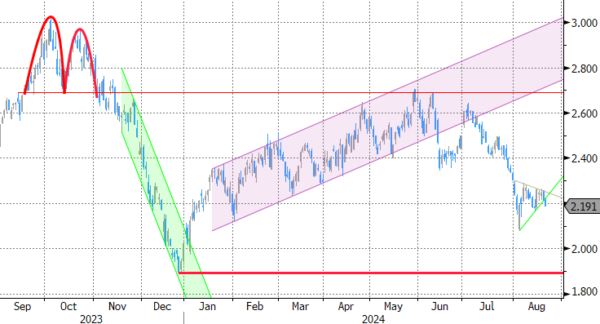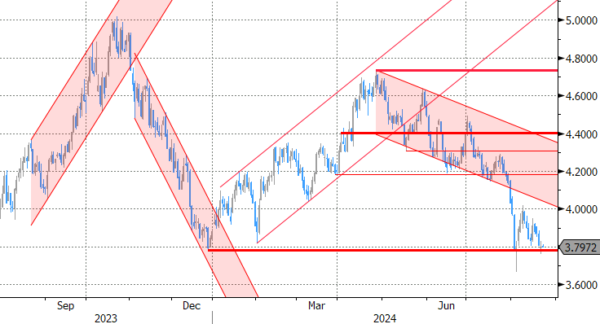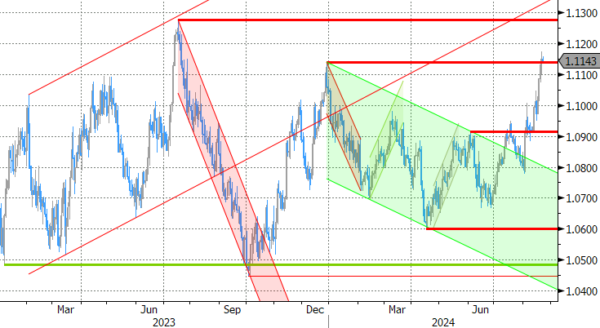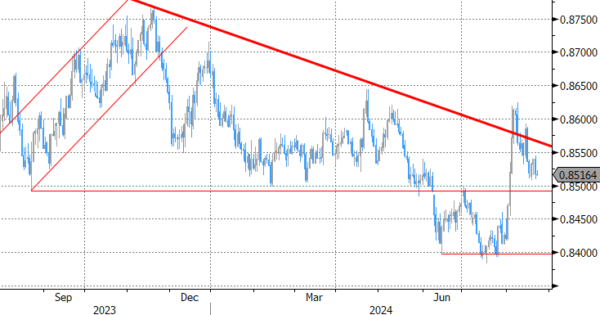Markets
The US Bureau of Labour Statistics kept most of us waiting yesterday. The preliminary benchmark payrolls revision for the year through March 2024 eventually showed the feared, significant, downward revision. The actual payroll count was 818k lower or around 68k/month. That lowers the average monthly net job growth over the reference period from 242k to 174k which nevertheless remains solid. However, from a momentum and narrative point of view it adds to worries that the Fed could be behind the curve. With inflation becoming gradually more under control, the Fed has space to focus on the second pillar of its dual mandate: maximum employment. With the labour market tipping, this argues for a less restrictive monetary policy. We agree with that view, but still think that US (money) markets are taking it too far when it comes to rate cut bets this year and next. There’s no sense in fighting the strong market trends for now though. Minutes of the July FOMC meeting showed that the outcome (unchanged) was a closer call than expected. “Several officials observed that the recent progress on inflation and increases in the unemployment rate had provided a plausible case for reducing the target range 25 bps at this meeting or that they could have supported such a decision. The vast majority observed that, if the data continued to come in about as expected, it would likely be appropriate to ease policy at the next meeting.” The US dollar and the front end of the US yield curve drifted further south in the wake of the releases. Interestingly: the very long end of the US curve showed signs of fatigue. The US 30-yr yield even notched somewhat higher already. Daily changes ranged between -5.4 bps (2-yr) and +1.7 bps (30-yr). EUR/USD closed at 1.1150, above the December 2023 top of 1.1139. Eventually, the greenback also closed above the day’s softest levels. Key US equity indices gained up to 0.6% for Nasdaq. Today’s US agenda contains July PMI’s. Risks are tilted to the downside of expectations. We still think that US (ST) yields and USD will stick near recent lows as the possibility of a 50 bps lift-off in September won’t be off the table ahead of early September data releases (ISM’s, payrolls). In Europe, PMI’s and especially Q2 wage data are a wildcard. The latter risk staying more sticky, limiting the ECB’s room for action compared with the Fed.
News & Views
The Bank of Korea (BoK) left its policy rate unchanged at 3.5%. Governor Rhee Chang-young indicated that the central bank might be moving toward a rate cut at the upcoming meetings. The domestic economy has continued with its divergence between slowing domestic demand activities and vigorously growing exports. The BoK revised the 2024 growth forecast slightly to 2.4% from 2.5% in May. 2025 growth is seen unchanged at 2.1%. It assesses that inflation maintained its underlying trend of slowing down. CPI increased to 2.6% Y/Y in July due to higher petrol prices, but the core inflation rate remained steady at 2.2% and the BoK sees inflation slowing further (2.5% from 2.6% this year, 2.1% next year). The BoK statement concludes that the central bank will thoroughly assess the trade-offs among policy variables such as inflation, growth, and financial stability, and examine the proper timing of rate cuts while maintaining a restrictive monetary policy stance. Financial stability concerns (real estate prices and household debt) are a source of caution advocating a cautious approach.
The rift between the Hungarian central bank (MNB) and the government on the balance between fighting inflation and supporting (lagging) economic growth flared up yesterday. Hungarian finance minister Nagy assessed that the MNB is too focused on inflation and believes that inflation near 4% is low enough to start a more growth supportive policy. With economic growth only expected at a subdued 2% this year, Nagy thinks that the central should take supportive action potentially including initiatives such as the previous Funding for Growth program. Comments come as the central bank recently indicated that room to continue its easing cycle is becoming smaller (only one or two additional rate cuts of 25 bps this year; policy rate currently at 6.75%) ). The MNB meets next week. The rift between the MNB and the government often was a negative for the forint, but this time the HUF continues a gradual rebound on the easing of global financial conditions. EUR/HUF currently trades near 292.7.
Graphs
GE 10y yield
The ECB cut policy rates by 25 bps in June. Stubborn inflation (core, services) make follow-up moves less evident. Markets nevertheless price in two to three more cuts for 2024 as disappointing US and unconvincing EMU activity data rolled in, dragging the long end of the curve down. The move accelerated during the early August market meltdown.
US 10y yield
The Fed in its July meeting paved the way for a first cut in September. It turned attentive to risks to the both sides of its dual mandate as the economy is continuing to move better in to balance. Money markets tend to err in favour of a 50 bps lift-off. The pivot weakened the technical picture in US yields with another batch of weak eco data pushing the 10-yr sub 4%.
EUR/USD
EUR/USD moved above the 1.09 resistance area as the dollar lost interest rate support at stealth pace. US recession risks and bets on fast and large (50 bps) rate cuts trumped traditional safe haven flows into USD. EUR/USD 1.1139 (Dec 2023 high) is under test. 1.1276 (2023 top) serves as next technical references.
EUR/GBP
The BoE delivered a hawkish cut in August. Policy restrictiveness will be further unwound gradually 0on a pace determined by a broad range of data. The strategy similar to the ECB’s balances out EUR/GBP in a monetary perspective. Risk-off proved a more important driver of GBP recently, triggering a return from 0.84 towards 0.86.


















